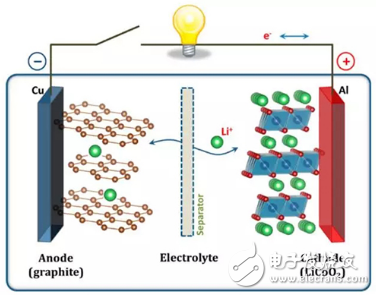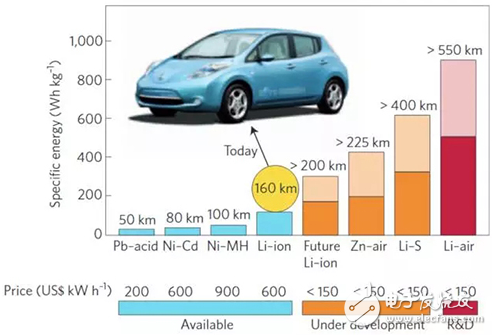With the development of social science and technology, people's food, clothing, housing and transportation are inseparable from the support of energy. From small items such as mobile phones and laptops to transportation, etc., they have become an indispensable part of people's lives. Although traditional energy sources such as crude oil have high-efficiency energy output capabilities, their environmentally unfriendly (such as large amounts of carbon dioxide emissions) and other shortcomings have become a problem that cannot be ignored in today's society. New energy sources such as solar energy and wind energy have great potentials, but because of their strong dependence on the environment at the time, it is still challenging to be able to perform electronic devices (such as automobiles) that require continuous functions. Therefore, one of the supporting forces to achieve these is to rely on the improvement of electronic energy storage equipment, that is, it is applied to different fields and has different types of batteries. Figure 1: Schematic diagram of the working principle of a lithium battery. In recent years, scientists have done a lot of research on batteries, such as alkaline batteries (such as Fe / Ni batteries and Zn / Mn batteries), traditional lead-acid batteries, lithium-sulfur batteries, and lithium-ion batteries that have attracted much attention. Compared with other batteries, lithium-ion batteries are favored by people because of their high specific energy, high operating voltage, long cycle life, low self-discharge, no memory and environmental protection. They are widely used in mobile phones and Laptops, etc., are also ideal for next-generation plug-in hybrids and electric vehicles. Lithium-ion battery adopts a rocker-like working principle. During charging and discharging, Li+ shuttles back and forth between the positive and negative electrodes, swinging from side to side, and reciprocating to realize the charging and discharging process of the battery. Since various electrochemical energy storage materials are different in material system and design, technical indicators are also different. Japan's New Energy Industry Technology Development Agency (NEDO)'s Li-EAD program sets a high-performance indicator that the battery will reach 700Wh/kg by 2030. At present, lithium-ion batteries can not achieve this goal, and the theoretical calculation energy density of lithium-air batteries can reach 12000Wh/Kg, exceeding the index proposed by NEDO. Before we elaborate on the lithium-air battery, let's briefly introduce the lithium-ion battery. Principle of lithium ion battery A lithium-ion battery consists of three parts: a positive electrode (usually a layered structure of lithium cobaltate and a cobalt nickel manganese lithium compound, a spinel-structured lithium manganate, an olivine-structured lithium iron phosphate), and a negative electrode (usually graphite). Layer) and electrolyte; wherein the redox reaction occurs in the positive and negative electrodes, and the electrolyte acts as a medium for transporting ions. Specifically, during the discharge process, lithium ions run through the electrolyte to the positive electrode under the action of the internal electric field, while the electrons that run away at the negative electrode flow to the positive electrode through the external circuit (the specific reaction is intercalaTIon, interested students can google [ 3]). The migration of electrons from the negative electrode to the positive electrode will do work, which is the energy used to support the operation of the electronic device. As the name suggests, the process of charging is the reverse of the discharge process. Main limitations of lithium-ion batteries There are many factors that affect lithium ions, such as temperature, rapid charge and discharge, theoretical capacity of materials, and energy density. Among them, energy density and theoretical capacity are two main aspects limiting lithium-ion batteries. Here we first talk about an important concept - Energy Density. Energy density, also called specific energy, written interpretation refers to the amount of energy stored in a certain space or mass material. Popular point is the energy contained in a unit volume or unit mass. In the battery industry, it is often used to compare the amount of electricity stored in a unit of weight. For example, lithium ion batteries with high energy density in existing commercial batteries have an energy density of about 500 Wh/Kg. As described above, such energy density is not enough to replace gasoline (energy density is about 13 000 Wh/Kg) for realizing automobiles. Purely electric. There is no harm without comparison. The energy density of traditional lithium-ion batteries (0.05-0.1 kwh/Kg) is less than 1% of the energy density of motor gasoline (13 kwh/Kg, Chevrolet Volanda)! Why are lithium-ion batteries so inefficient compared to traditional energy sources so popular and recognized? This starts with the structure of a lithium-ion battery. Careful readers have noticed that in Figure 1, the styles of the positive and negative electrodes seem to be different. For example, the negative electrode is some frame and the positive electrode is some piece of blue brick, but these are not the key points, but the authors want to indicate that the materials forming the positive and negative electrodes are different. But what they have in common is the orderly queuing of mung bean-like lithium ions. This is because during the migration of lithium ions through the electrolyte to the negative electrode, it will merge with some of the lithium ions that have arrived earlier. If there is no layered structure, these first-time lithium ions will form a crystal structure, which is academically called dendrites. These crystals will grow faster than the normal and negative poles, making the entire battery short-circuited from the inside. In general, it is like everyone has to go to the parking, and at the entrance, they are not allowed to make a long queue of traffic jams. The layered structure of the positive and negative electrodes plays the role of orderly storing the lithium ions coming at different times, like a parking space. Therefore, positive and negative electrodes with an ordered layered structure are indispensable for rechargeable batteries (Fig. 2). However, the positive and negative materials, as well as the electrolyte, do not give energy during discharge discharge. This drags down the overall energy density of the battery. Figure 2: Working principle of lithium battery: a. lithium metal battery; b. lithium ion battery. The layered structure can store lithium ions in an orderly manner to prevent the formation of dendrites. Another major factor affecting lithium-ion batteries is the capacity of the electrode material itself. It is worth noting that the positive electrode is an important part of the lithium-ion battery, and its performance largely determines the final performance of the battery. Many lithium-ion batteries Significant technological advances are closely related to the technological advancement of cathode materials. Known positive electrode materials which can be put into practical use include lithium cobalt oxide and cobalt nickel manganese lithium compounds having a layered structure, lithium manganate having a spinel structure, and lithium iron phosphate having an olivine structure. However, with the increasing demand of the global electric vehicle market, the development of lithium-ion batteries has been seriously hindered. The development bottleneck is mainly how to improve the charge-discharge ratio capacity of the cathode material to meet high specific energy and high charge-discharge power. Claim. Compared with today's commercial carbon anode materials (actual specific capacity of 330-360 mAh/g), the actual specific capacity value of the cathode material that has been put into use is only between 120 and 250 mAh/g, which is still far lower. The capacity of the anode material; its relatively low specific capacity/energy density is the current research status of cathode materials, which is the primary factor that restricts the development of lithium-ion batteries. Second, the cost of the cathode material is also one of the important factors affecting the development of high-capacity lithium-ion batteries. In general, the preparation of a positive electrode material requires the use of a rare transition metal element (e.g., cobalt, nickel, etc.) in large quantities. On the one hand, metal resources such as cobalt and nickel have limited reserves on the earth, which are not suitable for large-scale mining and excessive consumption (which runs counter to national sustainable development strategies); on the other hand, the use of rare metal elements will raise the manufacturing cost of batteries. It is not conducive to the large-scale popularization of high-performance lithium-ion batteries in the future (for example, practical applications in fields such as energy storage power stations). In addition, the heavy use of heavy metals such as cobalt, nickel and manganese will cause greater harm to the environment such as soil and water, and pose a serious threat to the lives of humans, animals and plants. solution However, the method is always more problematic. In order to further increase the energy density of the rechargeable battery, reducing the weight of the battery has become a breakthrough. Although it is temporarily impossible to find a material with a higher energy-to-mass ratio than lithium metal, we can reduce the weight of the battery as a whole, thereby increasing the overall energy density of the battery. The most representative one is the lithium-air battery. The theoretical energy density of lithium-air batteries can reach 12000Wh/Kg, which is comparable to the ultra-high energy density of gasoline, making it possible to completely replace gasoline, and truly realize the ultra-long journey of pure electric vehicles (Figure 3). Figure 3: Comparison between various types of batteries.
Aluminium wire as a good anticorrosion material,in steel structure surface anti-corrosion(container,dam and sluice gate,ductile iron pipe,bridge etc.)
Aluminum Wire,Zinc Aluminum Wire,High Pure Aluminum Wire,Aluminum Alloy Welding Wire Shaoxing Tianlong Tin Materials Co.,Ltd. , https://www.tianlongspray.com


